What Hi-Fi? Verdict
A well-built, well-designed pair of loudspeakers that sound every bit as good as they look. While they're only suitable for smaller rooms, the striking style and sound offer excellent value in the world of hi-fi.
Pros
- +
Italian flair
- +
Handcrafted individuality
- +
Great value
Cons
- -
Low-ish impedance
- -
Low sensitivity
- -
For small rooms only
Why you can trust What Hi-Fi?

This review and test originally appeared in Australian Hi-Fi magazine, one of What Hi-Fi?’s sister titles from Down Under. Click here for more information about Australian Hi-Fi, including links to buy individual digital editions and details on how to subscribe.
If, like Chario, you are a small, boutique hi-fi manufacturer that wants to save money on something that has absolutely nothing to do with the quality of the products you’re making, one way to do this is by cutting down on your photography costs, because professional photo shoots are expensive.
And one way to do this is to build products that look identical, so you can get a professional photographer to shoot one model, then use the same photographs for all your other models.
Now I am not saying that this is the reason that Chario’s Constellation II Lynx looks identical to the Chario Constellation II Delphinus, but there’s no doubt that – in photographs at least – the two appear to be absolutely identical.
However, just as the mother of identical twins can tell them apart, Chario’s designer could easily point out the differences to you, and if you see them side-by-side in the flesh, so to speak, you wouldn’t have any difficulty telling them apart either.
For starters, the Lynx is the ‘baby’ in the Constellation II range, at just 360mm high (50mm less high than the Delphinus), and just 200mm wide and deep (compared to the Delphinus at 230mm wide and 330mm deep). And although the Lynx shares the same oddly large tweeter as the Delphinus, it has a smaller bass/midrange driver... one that’s rated with a diameter of 130mm, as against the Delphinus’s 160mm bass/mid driver.
It’s worth noting right here in the introduction that the ‘II’ indicates that in fact there was originally a Chario Constellation Lynx, so the model reviewed here is an updated version of that original loudspeaker (about which I’ll go into in more detail in the main body of the review). I don’t think that’s really made clear by using just two Roman numerals (II) so I have used ‘MkII’ throughout this review to make it more obvious that this is a ‘new’ speaker for Chario.

The equipment
I said the Constellation MkII Lynx’s tweeter was ‘oddly large’ because in a world where the 25mm diameter dome tweeter reigns supreme (though of course, there are exceptions), the Lynx’s soft-dome tweeter is 38mm in diameter.
The latest hi-fi, home cinema and tech news, reviews, buying advice and deals, direct to your inbox.
The larger diameter of the tweeter on the one hand increases mass, which drags down the high-frequency extension, but on the other hand means that the voice-coil diameter is larger, so there’s more wire in the gap, and thus potentially higher efficiency and higher power-handling, so there’s a bit of swings and roundabouts in play here.
In the MkII Lynx’s tweeter, the dome is at the centre of a very large (130mm diameter) face-plate that seems to act as a horn as well as a face-plate, which would further improve the efficiency of the tweeter while at the same time also improving dispersion. The tweeter’s face-plate is secured to the baffle by star-headed wood screws, rather than by bolt/nut fixings, and is recessed into it to avoid deleterious edge effects.
Finally, in a world where neodymium is becoming the preferred magnetic material for drivers, the MkII Lynx has a conventional ferrite magnet, albeit one that’s very large and very heavy.
The crossover point between the tweeter and the bass/midrange driver is at 1.5kHz, a frequency that’s the same as the Delphinus. In this case, because the MkII Lynx has a smaller driver, it theoretically is more easily able to get up to this frequency, albeit at the cost of losing some extension in the low frequencies because of the reduced cone excursion and smaller cone area.
The chassis of the Mk II Lynx’s bass/midrange driver chassis is not actually round, which makes any single-figure measurement of it rather misleading. It would seem that the 130mm dimension quoted by Chario is the distance between the screw mounting holes on the chassis, which is a pretty common method of stating driver diameter. However, if you want to hang some more revealing figures on the size of the bass/midrange driver, it’s 135mm across horizontally and 152mm from corner edge to corner edge.
The moving part of the driver has a diameter of 115mm (including the roll surround) and the cone itself is 95mm in diameter. However the important dimension for any driver is the effective cone area (Sd) that derives from what’s called the Thiele/Small diameter, which is the distance from half-way across the roll surround on one side to half-way across the surround on the opposite side, and this is 100mm, which gives an effective cone area (Sd) of 79cm².
The cone is made from a paper compound, while the cone suspension, which has a normal ‘traditional’ roll surround, is made from a rubber compound. The central dust-cap is dished, rather than domed, which gives a much cleaner ‘look’.
Most small loudspeaker manufacturers do not build their own drivers, and even those that do supposedly ‘build our own drivers’ actually do so by assembling parts they have purchased from other manufacturers – cones from one supplier, surrounds from another, chassis from another, magnets from someone else, and so on. Chario says it is different, and claims on its website: “Chario is in the very small world of handcrafting companies that totally make their loudspeakers, drivers and cabinet, to meet 100% of the project parameters.”
The Italian translation means you could read this sentence two ways, and Chario says its operations are fragmented right across Italy, with its headquarters located in Vimercate, near Milan, a small factory in another town close to Vimercate, and a larger factory where all the cabinetry is built that’s near Vicenza. The company says that both the bass/midrange drivers and the tweeters are made “in a factory near Ancona, on Italy’s eastern coast.”
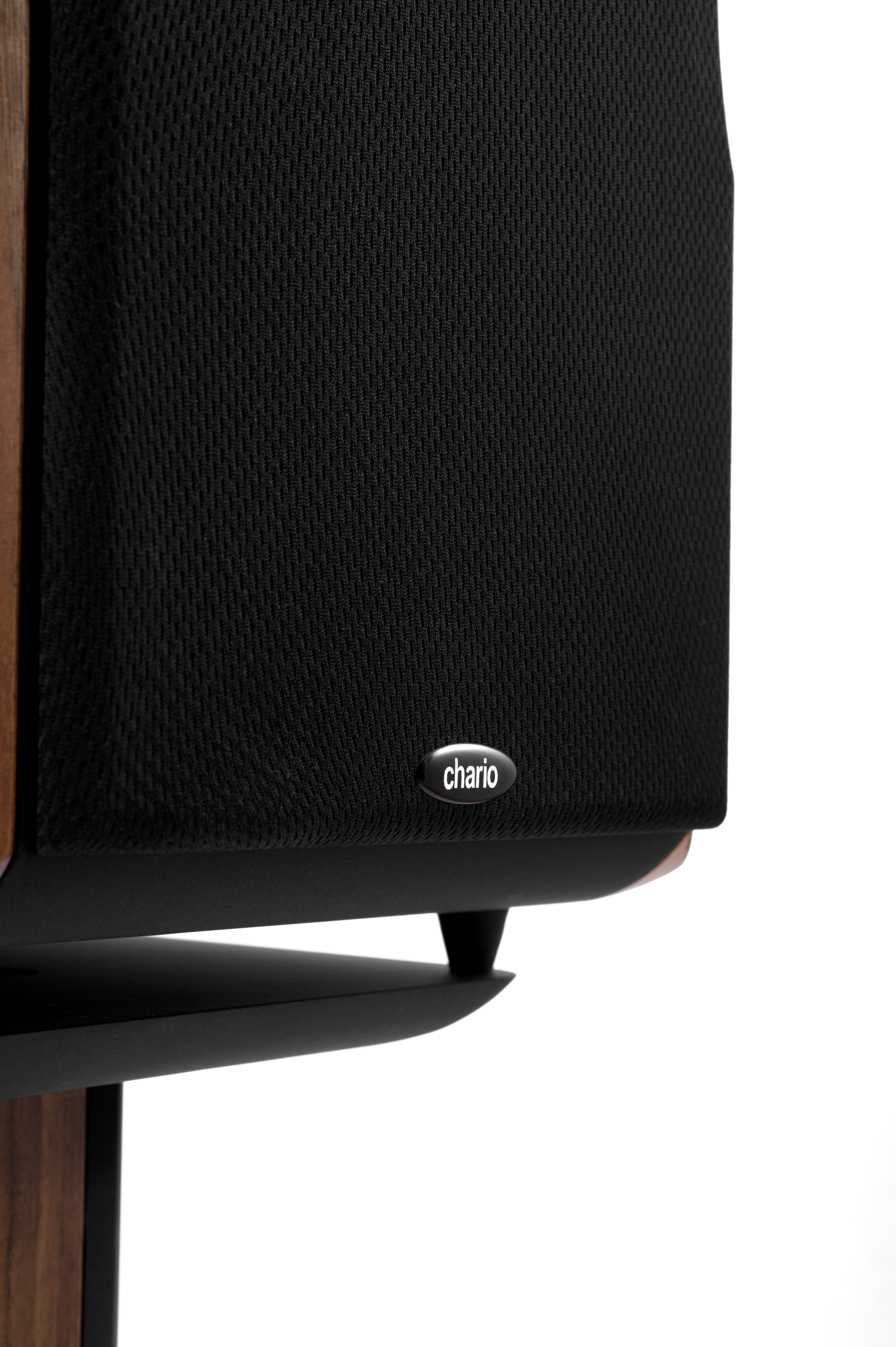
The MkII Lynx is a bass-reflex design, where the designer uses the output from the rear of the cone to deliver additional bass, but whereas most designers put the port on the front or rear of the cabinet, Chario’s designer has put the Lynx’s port on the bottom of the cabinet, firing downwards.
This, of course, means that the cabinet must be elevated above whatever surface it’s placed on, in order for the sound to be delivered efficiently into the room. On the MkII Lynx this is achieved by using either rubber feet or steel spikes (your choice, because both are provided). It also means that the bass response will be quite different if you use the speakers on, say, a shelf, rather than a stand, because the increased surface area of a shelf underneath the speaker will reinforce the bass more than the limited surface area at the top of a speaker stand.
As for the port itself, the one on the MkII Lynx is 185mm in length and 55mm in diameter, with neither its entry nor its exit flared. What is on the rear baffle is a single pair of gold-plated multi-way speaker connectors that accept banana plugs, spades, ring connectors and bare wire. Personally, if I had designed these speakers, I would have put the connectors underneath the cabinet, where they’d be completely out of sight.
The Lynx’s cabinetry is a lesson in luxury and when you’ve seen and touched those beautiful side panels you won’t be surprised to learn that they’re not made of MDF covered by veneer, but from solid blocks of wood hewn from trees grown in Italy. Again, quoting from Chario’s website: “In a Chario everything speaks Italian, from the massive wood used for the cabinet construction, strictly of Italian origin, to the drivers, designed and made in Italy.”
I did wonder why, given this emphasis on its Italian heritage, the company name itself doesn’t sound very Italian, and indeed Google Translate (my authority on these matters) refused to recognise it as an Italian name at all, instead suggesting that it might be Welsh! It turns out that the company’s founders, Carlo Vicenzetto and Mario Marcello Murace, combined parts of their first names to create the unusual company name. (Though for some reason, Vincenzetto used the anglicized version of his first name (Charlie) rather than his native birth name.)
And as for the “Constellation II’ in the Lynx’s model name, it appears that the ‘II’ is to indicate that there was a previous Constellation (I) range, of which production ceased in 2016, and the ‘Constellation’ is because the Lynx is part of a Constellation ‘Series’ of speakers, the others in which are the already-mentioned Delphinus, the Cygnus and the Pegasus... names that are also attributed to constellations of stars.
As for how the Lynx Constellation of stars got its name, that’s actually pretty interesting in itself. It was so-named by Polish astronomer Johannes Hevelius who created the constellation to fill a ‘gap’ between the two neighbouring constellations, Auriga and Ursa Major. He said he named it Lynx “because it was pretty faint and it took the eyesight of a lynx to see it.”

Listening sessions
Whereas some manufacturers will insist that their smallest pair of speakers could be used in a football stadium, Chario is pretty specific about the size of the room it recommends for the Lynx, saying “not more than 14 square metres, and not less than 6 square metres”.
To put these measurements into some kind of perspective for you, six square metres is only a little larger than the space occupied by a king-sized bed, while here in Australia even that larger dimension (14 square metres) is about the size of a room that’s usually on the floor plan as a ‘second’ bedroom or a study.
But full marks to Chario for being realistic about room acoustics. It’s just a simple matter of physics that as room size increases, so too does the need for loudspeakers to have larger bass drivers and larger cabinets. But it’s physics that most speaker manufacturers choose to ignore or gloss over entirely in their quest for increased sales at any cost. Chario is obviously more interested in having satisfied customers than in increasing its sales figures at any cost.
I always listen to small speakers both on speaker stands in my main listening room and on a long side-table I have in one of my other listening rooms, and I find that I nearly always prefer the stand-mount option. But not this time. I really thought the Chario Constellation MkII Lynx review pair sounded rather better when they were perched on my side-table.
There wasn’t all that much difference, but I did think there was slightly more low-frequency extension, and a slightly more balanced bass/midrange presentation when they were on the side-table. So if you have a similar arrangement, I’d recommend using it, after which my next recommendation would be to try placing the speakers on a bookshelf. Both options have the advantage of saving money (no need to pay for stands) and increased stability thanks to the-more stable base afforded by the non-movable surfaces.
Irrespective of the speaker position (stand-mount or table-mount) I thought the overall sound of the Chario Constellation MkII Lynx was excellent, with its stand-out feature being a very clean, natural midrange sound that has a beautifully rich warmth to it.
When I first set up the speakers I thought the treble was fractionally more forward than it should be, but as I’d toed both speakers in to fire directly at my listening position, it was a simple matter to reposition them so their backs were parallel with the wall behind them. This not only delivered the balance I expected, but also gained the seal of approval from my better half, because she thought that irrespective of the sound quality (but yes, she liked that too), she thought they simply ‘looked better’ this way. She was also very approving of the very large soft rubber feet supplied with them... I’ve more than once accidentally damaged our furniture in the past with ‘feet-scrapes’ caused by me being careless whilst positioning (actually, usually repositioning) speakers.
As with any small-driver/small-cabinet design, you should not expect too much in the way of deep bass from the Chario Constellation MkII Lynx, but there was certainly enough extension to be able to admire the incredible double-bass of Paul Chambers, both plucked and bowed, in his classic album Bass on Top. Classified as a ‘jazz’ album, you’ll hear how wildly misplaced such ‘generic’ categorisations can be when he and his quartet play the classic Otto Harbach/Jerome Kern tune Yesterdays.
Not only can you admire Chambers’ superb bowing technique on this track, but also the enchanting sound of Kenny Burrell’s guitar. Pianist Hank Jones and Art Taylor stay very much in the background on this one, but when they do chime in, the quality of the piano sound and that of the high-frequency cymbal sound, in particular, are clearly audible via the MkII Lynxes.
On the second track, Cole Porter’s You’d Be So Nice to Come Home To, Chambers discards his bow and you can appreciate not only his unbelievable pizzicato, but the incredible speed and precision of the Chario’s delivery of it. This time around Burrell takes an extended solo and you can use it to listen to the purity and balance of the Chario’s midrange sound. When Jones then chimes in with his own solo, the sound of his stabbed higher keys is amazing via the Charios.
And while he is playing, notice how, deep down in the bass, the MkII Lynxes are delivering Chambers’ backing exactly where it is supposed to be. The same is true on Charlie Parker’s famous Chasin’ The Bird, which the quartet delivers more cohesively than most, managing to make the disparate musical lines meld most magically.
If you really want deep bass, you’d be advised to use a subwoofer with these Charios and as I had a couple on hand for review I was able to experiment with how well they integrated with the MkII Lynx. I was impressed by how easy it was both with the two review loaner subs and also with my own subwoofer.
Depending on the sub I paired with them I used slightly different high-pass frequencies, but it was always in the range between between 125Hz and 200Hz. Letting a subwoofer handle the deep bass meant I could extract higher sound pressure levels from the Lynx, plus its lovely midrange sound became even lovelier, presumably from the reduction in Doppler distortion that resulted from the driver not having to do two things at once (i.e. deliver deep bass and midrange).

One of the many recordings I used to evaluate the midrange of the Chario MkII Lynx pair was Nina Simone’s album I Put A Spell On You. I really had to listen no further than the first track, from which the album takes its name, to reveal its superiority. First, the MkII Lynxes are so spectrally accurate that I could hear it was Nina Simone from the first note she sang. The sax sound on this track is monumental. I’m pretty sure it’s the sound of Rusty Bryant (just listen to that lip control!) and you’ll smile when you hear Nina scatting her version of Bryant’s backing.
It’s a bit sad that so few people have ever heard the original version of this song, which was composed and recorded by the Alice Cooper of his day, Jalacy Hawkins. And if you’d like to hear more modern versions of it, I rather like the covers by Annie Lennox and by Bette Midler.
The smoothness and rich warmth of the MkII Lynxes’ midrange is exemplified on Tomorrow is My Turn, a song written by Charles Aznavour (as L’amour c’est comme un jour and performed by him in the original French most recently as a duet with Sting) and whose signature hook was greatly borrowed from by Steve Arnold to compose his song for the James Bond movie Tomorrow Never Dies. Listen in particular to the change in the tone of Simone’s delivery at around 1:16, then the way she contrasts it around a minute further in. The superb midrange of the Chario MkII Lynx makes such contrasts crystal-clear.
To test the MkII Lynx’s high frequencies, it seemed appropriate to listen to a particular John Cage work famed for its tweeter-testing abilities. But listening to a work by Cage was also prompted because quite recently (September 7th) a small audience in the St. Burchardi Church in the town of Halberstadt, Germany, heard the first chord change in almost seven years in the slowest musical piece in the world, Organ²/ASLSP, an organ work by Cage, which started on Sept. 5, 2001 – the day that would have been Cage’s 89th birthday. The entire work takes 649 years to play, so the final note will not be played until some time in September 2640.
I listened not to this work, of course, (they’re still recording it) but to his much shorter Quartet 1 from Percussion Works Volume 1 whose challenging cacophony of percussive clangs, clonks and clinks tests not only your tweeters and the limits of your own hearing, but also, sad to say, your musical tolerances (which is to say that it’s not for everyone, unless you’re only using it to test tweeters!).
The tweeters in the MkII Lynx reproduced all these sounds with tremendous élan, and the repetitive nature of the work means that you can also use it to experiment with exactly how off-axis you’d like to position yourself with regard to the tweeters to ensure the best balance between the mids and the highs.
Final verdict
These are certainly very ‘Italian-looking’ speakers, not because they’re made in Italy, but because they look so similar to speakers made by Italy’s most famous loudspeaker manufacturer, Sonus Faber.
And it’s not only their looks... there are many sonic similarities as well. So you’ll probably be pleased to find that there’s very little similarity in pricing: indeed when I checked the recommended retail price of these little Italian speakers immediately prior to submitting this review for publication, the fact it was much lower than I’d imagined it might be came as a very pleasant surprise.
What may also come as a surprise is that despite Chario’s own “not more than 14 square metres” advice, and my own “small rooms only” note in the plus/minus panel, I think that if you listen at lowish to moderate volume levels, you could quite successfully use these speakers in larger rooms. Plus, of course, if you like the look and the sound, you could always step up to the larger Chario MkII Delphinus.
Lab test results
The graph shown below is the in-room on-axis frequency response measured by Newport Test Labs.

You can see that Chario Constellation MkII Lynx's frequency response has a response that’s clearly a little elevated at high frequencies plus it has a minor ‘kick’ upwards at around 150Hz, but overall, the response is very flat and linear, extending from 79Hz to 40kHz ±3dB.
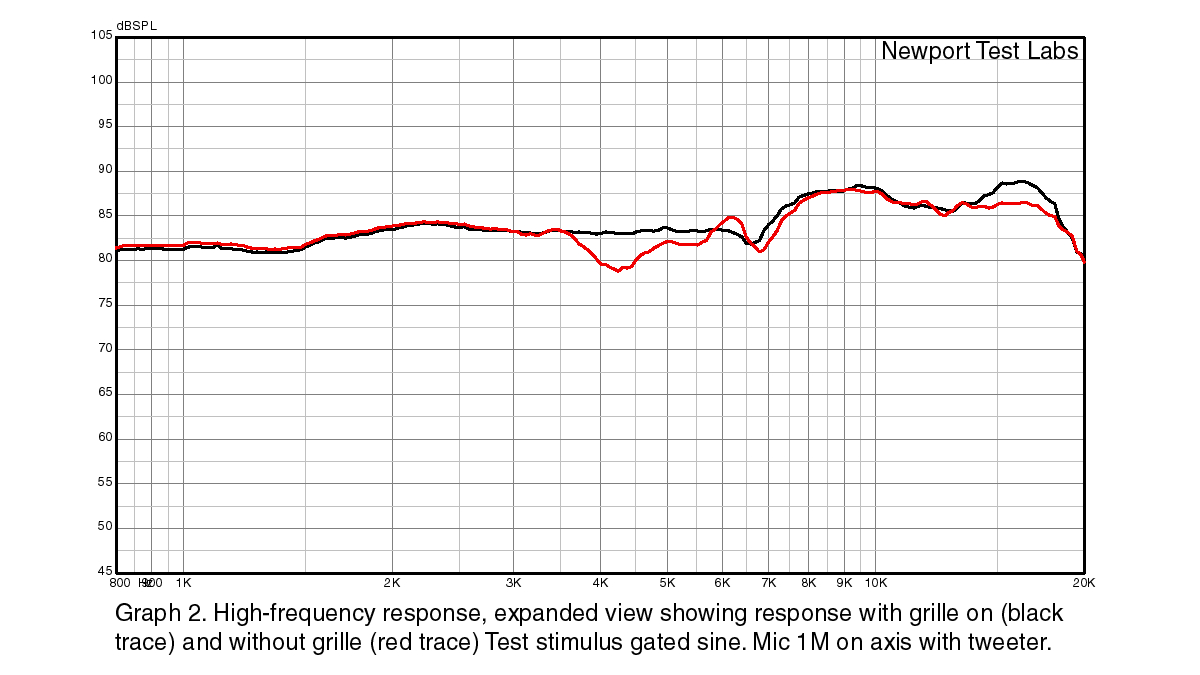
Graph 2 shows the high-frequency performance in greater detail, using a gating measurement technique that eliminates room effects and therefore shows the ‘true’ response above 800Hz. You can see that the response is almost ruler-flat out to 6.5kHz, where there’s a minor dip followed by a 5dB rise that peaks at 8kHz after which it shelves out to 10kHz before rolling off slightly to 13kHz, after which it rises once again to around +6.5dB before rolling off.
You can see from the differences between the response with the grille on (red trace) and the grille off (black trace) that the presence of the grille introduces some anomalies, the most significant of which is the 2.5dB dip centred at 4.2kHz, so you will get the most balanced response by listening without the grilles.

Graph 3 compares the on-axis/grille-off high-frequency response (black trace) with the 15° off-axis response (red trace) and the 30° off-axis response (green trace).
You can see that the high-frequency response above 7kHz drops away significantly with increasing angle. On the basis of this graph, I would imagine that a 20° off-axis listening position would result in the most linear delivery of high frequencies.
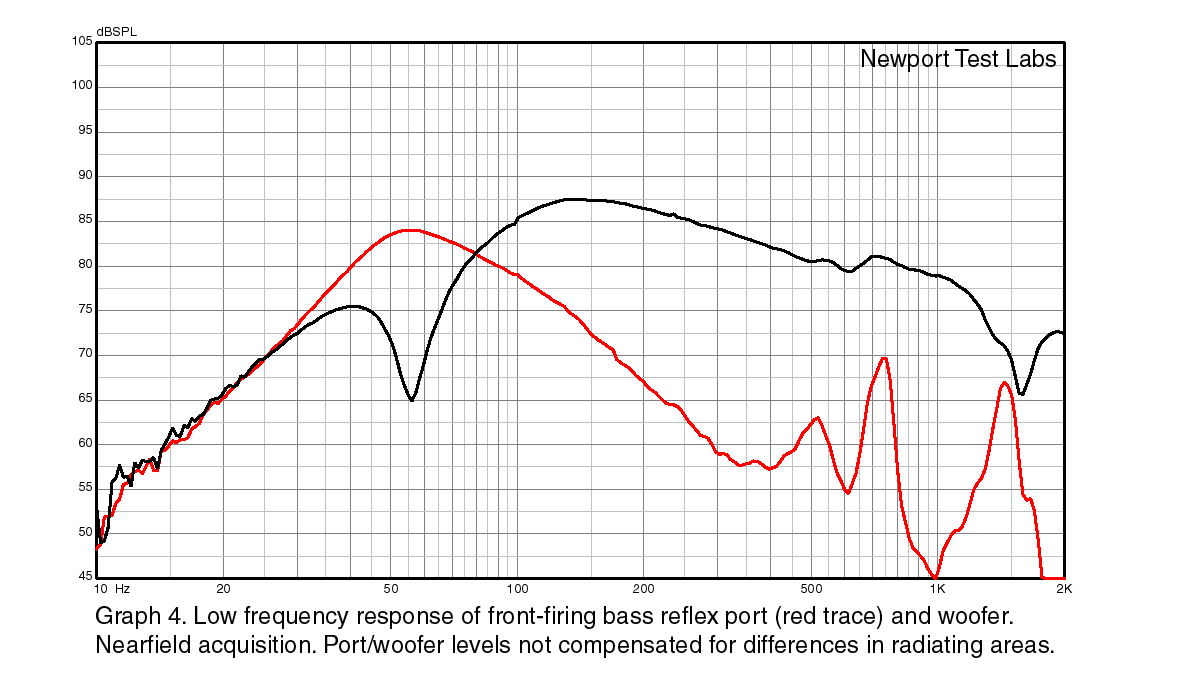
The low-frequency performance of the Chario Constellation MkII Lynx is shown in Graph 4, with Newport Test Labs this time using a near-field measurement technique that delivers the response that would be obtained anechoically, effectively removing boundary loading effects.
You can see that the low-frequency response of the Lynx’s bass/midrange driver starts rolling off at around 130Hz to a minima at 56Hz, which is the port tuning frequency. The bass reflex port’s output is textbook for this cabinet alignment, peaking at 56Hz and rolling off smoothly either side at around 16dB per octave. The port’s output is very smooth save for two resonances, one at 750Hz and the other at 1.4kHz.
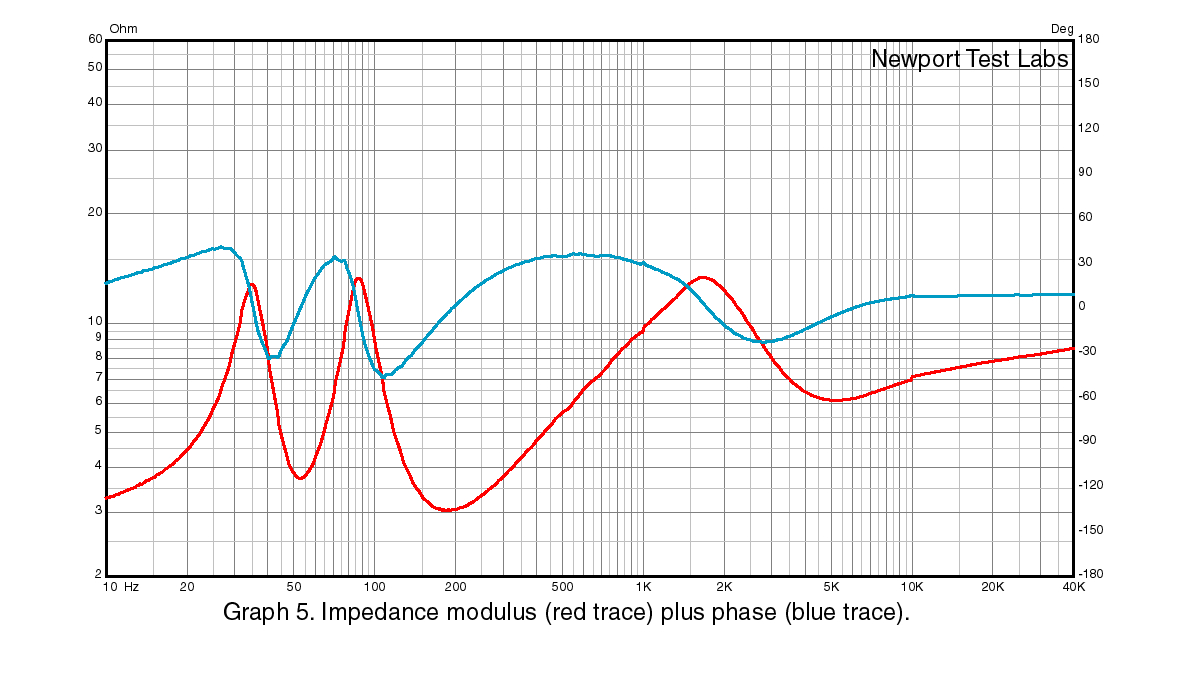
The impedance of the Chario Constellation MkII Lynx, as measured by Newport Test Labs, is shown in Graph 5 (red trace) along with the measured phase (light blue trace). You can see that despite being classified as a 4Ω speaker, the MkII Lynx’s impedance drops below 4Ω between 130Hz and 325Hz and is just 3Ω at 180Hz. Save for the resonant peaks, the entire impedance is below 8Ω across the audio band. The phase angle is very well-controlled, remaining within ±30° right across the measured range, save for one small -45° displacement at 110Hz.
I would certainly recommend that any amplifier used to drive the Chario Constellation MkII Lynx should be capable of driving 4Ω loads, and such an amplifier would not be bothered by the fact that the impedance drops below this between 130Hz and 325Hz.
Incidentally, I suspect that Chario has made an error with its specification for the Lynx, because whilst classifying the design as a 4Ω design, it then says the minimum impedance is “5.8Ω.” The stated phase angle (apparently known as “argument” in Italian) is ±36°, which is very close to Newport Test Labs’ measurement of this parameter.
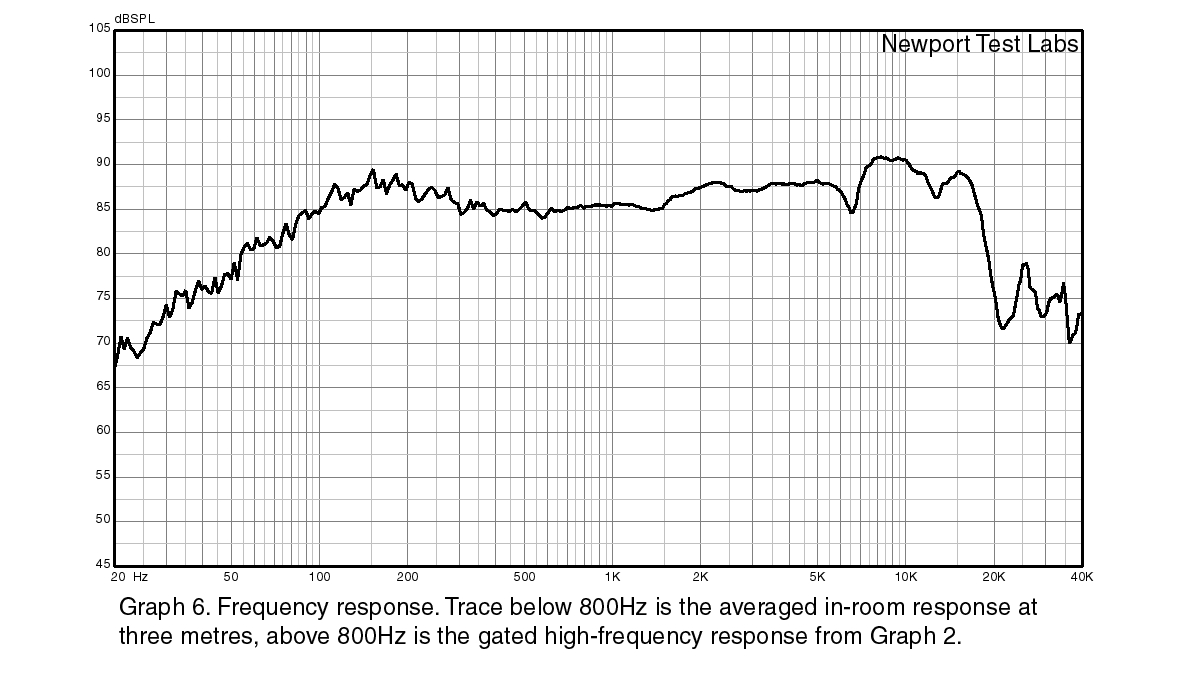
As I would expect of any design that combines a smallish diameter bass/midrange driver with a small-volume enclosure, the Chario Constellation MkII Lynx was not overly efficient at converting electrical power into acoustic power, with Newport Test Labs measuring sensitivity as 86dBSPL at one metre, using its standard measurement technique. This is 1dB lower than Chario’s specification of 2.83Veq but it’s also exactly what I would have predicted for this design, so I am quite happy with the result.
All the tests conducted by Newport Test Labs prove that the Chario Constellation MkII Lynx is a well-built, well-designed loudspeaker.
Australian Hi-Fi is one of What Hi-Fi?’s sister titles from Down Under and Australia’s longest-running and most successful hi-fi magazines, having been in continuous publication since 1969. Now edited by What Hi-Fi?'s Becky Roberts, every issue is packed with authoritative reviews of hi-fi equipment ranging from portables to state-of-the-art audiophile systems (and everything in between), information on new product launches, and ‘how-to’ articles to help you get the best quality sound for your home.
Click here for more information about Australian Hi-Fi, including links to buy individual digital editions and details on how best to subscribe.


